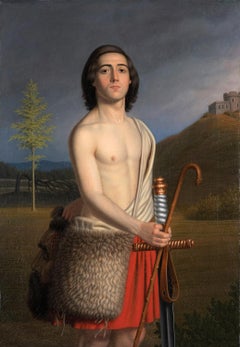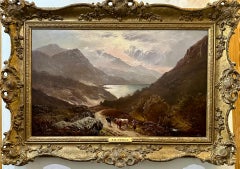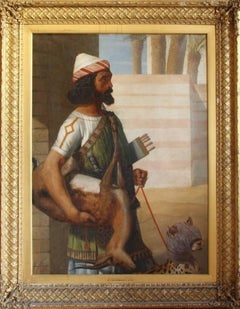John Rogers Herbert Art
to
1
1
1
1
Overall Height
to
Overall Width
to
1
1
1
1
1
1
6,935
3,285
2,514
1,213
1
1
Artist: John Rogers Herbert
David with the Head of Goliath, 19th Century Victorian Oil
By John Rogers Herbert
Located in London, GB
John Rogers Herbert RA
1810- 1890
Oil on canvas, dated '1850' lower right on sword strap
Image size: 33 ½ x 23 ½ inches
Gilt Watts frame
This striking painting, depicts David as a y...
Category
1850s Victorian John Rogers Herbert Art
Materials
Oil
Related Items
Fine Large Victorian Signed Oil Fisherman in Highland River Landscape1880's
Located in Cirencester, Gloucestershire
Fisherman in Highland Landscape
by James Mudd (English, 1821 - 1906)
signed oil on canvas, framed
framed: 28.5 x 41 inches
painting: 24 x 36 inches
provenance: private collection, En...
Category
Late 19th Century Victorian John Rogers Herbert Art
Materials
Oil
H 28.5 in W 41 in D 1 in
Scottish 19th century Highland landscape, with a figure and cattle on a pathway
By Sidney Richard Percy
Located in Woodbury, CT
Wonderful Scottish 19th century Highland landscape, with a figure and cattle on a pathway overlooking a Loch
This piece is signed lower right and is framed in a Vintage Gold Leaf fr...
Category
1850s Victorian John Rogers Herbert Art
Materials
Canvas, Oil
Free Shipping
H 17 in W 23 in
Antique Scottish Highland Loch landscape, with sunlit streaming onto the water
By Francis E. Jamieson
Located in Woodbury, CT
Francis Jamieson was a painter in oil and watercolor of highland landscapes and coastal scenes. (The work of this highly prolific artist is curious since the oils and watercolors have two quite distinctive styles and subject matter. The oil paintings are most frequently seen and these are highland landscapes or loch scenes - sometimes they appear to be signed with pseudonyms such as 'W. Richards' and 'Phil Hips' - the location is usually inscribed on the reverse. The watercolors are often coastal scenes with boats and figures on a shore, painted in a more traditional Victorian style, and possibly pre-date the oils. F. E. Jamiesons's beach scenes were published as postcards around 1920 by G. Ajelli & Co. of London on a textured card to give the appearance of oils.
Jamieson is known to have traveled widely in the South of England between the wars selling his work but does not appear to have exhibited.) This quote in parentheses is taken from Jeremy Wood's excellent book 'Hidden Talents - A Dictionary of Neglected Artists Working 1880-1950'.
-
Work by Francis Jamieson can be seen at the usual sites. Please note that on all these sites you will find F. E. Jamieson variously listed as Francis E. Jamieson, F.E.Jamieson, Frank E. Jamieson, Frederick E. Jamieson etc. You may also find some listings under his various pseudonyms of Arnould Pienne, Charles Maurice, Graham Williams...
Category
1910s Victorian John Rogers Herbert Art
Materials
Canvas, Oil
Free Shipping
H 21 in W 29 in
Antique English Fox hunting scene with huntsman jumping with hounds in a field
Located in Woodbury, CT
Tom Ivester Lloyd 1871-1942 was a fine artist who worked mainly in water colour but was also very accomplished in oils.
He served in the first war and produced pictorial records which are now in the army museum. He was a keen hunting man and was Master of the Sherrington Foot Beagles.
He was a great hound man and wrote and illustrated a book on hounds.
Acquiring an early 20th-century English fox hunting...
Category
1920s Victorian John Rogers Herbert Art
Materials
Oil, Board
Free Shipping
H 12 in W 16 in
Antique Breton Fishing Scene French Oil Painting on Canvas Fishermen & Women
Located in Cirencester, Gloucestershire
Breton Fisherfolk on the Shore
French School, early 1900's
signed with initials HB
oil on canvas, unframed
canvas: 15.5 x 20 inches
provenance: private collection, France
condition: ...
Category
Early 20th Century Victorian John Rogers Herbert Art
Materials
Oil, Canvas
19th century English marine Sailing scene of Dutch fishing boats by a harbor
By Henry King Taylor
Located in Woodbury, CT
Henry King Taylor was a marine and coastal scene painter who lived in London. He exhibited at the Royal Academy from 1859 to 1864 with titles includi...
Category
1850s Victorian John Rogers Herbert Art
Materials
Canvas, Oil
Henry King Taylor19th century English marine Sailing scene of Dutch fishing boats by a harbor , 1859
Free Shipping
H 21 in W 33 in
Antique oil on canvas, English landscape with River, Church, Cottage at Sunrise
By Daniel Sherrin
Located in Woodbury, CT
Well-painted English late 19th century RIver landscape, with river, Church Cottage at Sunrise
Daniel Sherrin 1868-1940 signed L. Richards This is a framed original oil painting on c...
Category
Early 1900s Victorian John Rogers Herbert Art
Materials
Canvas, Oil
Free Shipping
H 27 in W 37 in
Arrest of Louis XVI & Marie Antoinette at Varennes - 19th Century Oil Painting
By Robert Alexander Hillingford
Located in Gerrards Cross, GB
‘The Arrest of Louis XVI and Marie Antoinette at Varennes’ by Robert Alexander Hillingford (1828-1904).
The painting – which depicts the King and Queen of France’s failed attempt to...
Category
Late 19th Century Victorian John Rogers Herbert Art
Materials
Oil
Ezekiel in the Valley of Dry Bones
By Philip Burne-Jones
Located in New York, NY
Provenance:
Christie’s, London, 3 March 1922, lot 46 (with The Tower of Babel);
James Nicoll
Private Collection
Sotheby’s, London, 29 March 1983, lot 157
Private Collection, New Yo...
Category
Late 19th Century Victorian John Rogers Herbert Art
Materials
Oil, Canvas
Antique oil 19th century View of Venice, The Grand Canal Venice
By William Meadows
Located in Woodbury, CT
View of the Grand Canal in Venice by one of England's best-known landscape and Venetian painters.
This example is a very well-painted piece and is a great composition.
It is framed in an English Classic running pattern frame.
Tracing the story of William Meadows, the son of James Meadows, is sometimes a little difficult. In earlier census returns he gave his place of birth as Epping, but in later census returns he said that he was born in Mountnessing in about 1825. Between 1841 and 1901 William is recorded as William James, William George, and in 1881 simply as George, and these apparent changes of name were explained by a chaotic personal life which contrasts with his tranquil paintings of the English countryside and Venice.
An entry in The Fine Arts Journal in 1847, concerning the Theatre Royal, Dumfries, reveals that "The scene-painter is Mr. W.J.Meadows, the son of Mr. Meadows, of the Surrey”. Initially, William had begun his career by following in the family footsteps at one of the theatres where his grandfather had performed. However, his training as a scene painter most probably came closer to home under his father's tuition, possibly at The Lyceum Theatre in London in 1844. (See the previous page on James Meadows for further details).
In 1850, William married Lydia Maria Jarvis (born in Norwich c.1826) at St Pancras Old Church, close to St Pancras Station in London. By the time that the census was taken the following year, William and Lydia were living at 16, High Street in Poole, Dorset. So far it has been not been possible to identify a census entry for 1861 for the couple. However, when William exhibited "A scene in Surrey' at the Royal Hibernian Academy of Arts in Dublin in 1865, he gave his address as 187, Hampstead Road, London, not far from the St Pancras area once again.
The reason for William's obscurity in the 1861 census may lie partially in his financial difficulties, as well as his frequent changes of address. In 1864, The Law Journal's list of impending bankruptcy proceedings included an entry for "Meadows, William George (known as William James Meadows), artist, of Old Kent Road, previously of Beal Road, Old Ford, previously of Wanstead Flats, Wanstead". A family source has revealed that William tried changing career not long afterward, when he became the landlord of The Black Bull Inn in Fyfield in Essex on the 9th November 1866, and that he "gave an opening dinner there" on 29th November 1866. However, if William was trying to achieve financial stability by changing careers, the 1871 census would suggest that it was an unsuccessful interlude.
In 1871 William was recorded under the name of William George but is identifiable as the same person by his age, place of birth, and the personal details of his wife. He no longer gave his profession as an artist, but as an "Eating Housekeeper", back in the East End of London and living at 200, High Street in Shoreditch. Two servants were living with the couple, but more unusually there was also another resident, whose occupation was listed as "bailiff in possession". The presence of a live-in bailiff, therefore, seems to suggest that William's financial difficulties were far from over.
In addition to his financial woes, William’s marriage to Lydia also appears to have been a stormy affair. In 1867 in London she petitioned for a divorce from William, although she must have been initially reconciled to him as the couple was living together (with their bailiff!) in 1871. However in 1874, Lydia once again petitioned for a divorce and this time the separation was definitive, and Lydia moved to a separate address in Holborn where she was living at the time of the 1881 census as a "retired publican". William, meanwhile, married for a second time in Southwark in 1875, under the name of William George Meadows.
His second wife, Helen Grace Higgs, was born in Tipperary in Ireland in about 1841. By the time of the 1881 census, the couple was lodging over a pub at 87, High Holborn in London, where William is recorded simply as "George Meadows, Landscape painter". In the 1891 census, the couple was lodging at The Green Dragon...
Category
1890s Victorian John Rogers Herbert Art
Materials
Canvas, Oil
Free Shipping
H 28 in W 38 in
Antique English river landscape with figures, boats, swans, London , brown gray
Located in Woodbury, CT
An English river landscape with Swans, boats, barges on the banks of the Thames.
A very interesting river landscape composition of figures working on a boat, near a barge on the River Thames, London, circa 1885.
Robert Hamilton...
Category
1880s Victorian John Rogers Herbert Art
Materials
Oil
Free Shipping
H 17 in W 21 in
Huge 1880’s Irish Signed Oil Cottage & Figure in Highland Mountain Landscape
Located in Cirencester, Gloucestershire
The Highland Cottage
Irish School, 19th century
signed and dated 1888
oil painting on canvas, unframed
canvas: 30 x 50.5inches
provenance: private collec...
Category
1880s Victorian John Rogers Herbert Art
Materials
Oil
Previously Available Items
Magnificent C19th Oil Painting of Babylonian Nobleman with a Hunting Cheetah
By John Rogers Herbert
Located in London, GB
John Rogers Herbert TA, HRI (1810-1890)
The Hunting Cheetah
Signed, inscribed and dated ‘J.R. Herbert R.A./Paris 1853’ (lower left)
Oil on canvas
37 ¼ x 28 inches, 47 1/4 x 38 inches inc. frame
In the original frame
Provenance
Thomas Agndew & Sons
Sir Edward Bates, Gyrn Castle, North Wales
This striking portrait shows a Babylonian nobleman returning from a hunting expedition with his cheetah and its catch - a gazelle - which, from its distinctly curved horns and dark body stripe, can be identified as a Thomson’s Gazelle. The painting is important in a historical context as it dates from the time when archaeological findings, and their dissemination around the Western world, ensured that public fascination with Mesopotamia reached its height.
Herbert was a painter of portraits, historical genre and landscapes. His early work showed a preponderance of subjects derived from Italian history, following his visit to that country in
1836. These early compositions tend to be characterised by high drama and contraposto figurative groups, such as Pirates of Istria carrying off the Brides of Venice (1839). However during the 1830s he made contact with the Nazarenes, a German group of painters who cultivated a sharp-edged, flat style. Herbert’s aesthetic became more Nazarence in tendency (with its juxtaposition of decorative surfaces, The Hunting Cheetah, dated 1853, demonstrates the longevity of their influence). 1840 proved a seminal year for Herbert personally as he converted to Catholicism, much as a result of his friendship with the architect and man of letters Augustus Welby Pugin (1810-1852). It was Pugin who created the magnificent frame in which The Hunting Cheetah is presented. In the ensuring decades Herbert concentrated on religious subjects and submitted Pope Gregory Teaching the Boys to Sing (1846) as his Royal Academy diploma work. The same year he was one of the selection of artists chosen to decorate the interior of the New Palace of Westminster, and his contributions included nine Old Testament scenes...
Category
Mid-19th Century Old Masters John Rogers Herbert Art
Materials
Oil
Free Shipping
H 37.25 in W 28 in
John Rogers Herbert art for sale on 1stDibs.
Find a wide variety of authentic John Rogers Herbert art available for sale on 1stDibs. You can also browse by medium to find art by John Rogers Herbert in oil paint, paint and more. Not every interior allows for large John Rogers Herbert art, so small editions measuring 24 inches across are available. Customers who are interested in this artist might also find the work of George Armfield, William Shayer Senior, and Thomas Sidney Cooper. John Rogers Herbert art prices can differ depending upon medium, time period and other attributes. On 1stDibs, the price for these items starts at $30,675 and tops out at $30,675, while the average work can sell for $30,675.



